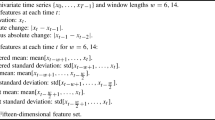Abstract
In linear time series analysis, the incorporation of the moving-average term in autoregressive models yields parsimony while retaining flexibility; in particular, the first order autoregressive moving-average model, ARMA(1,1) is notable since it retains a good approximating capability with just two parameters. In the same spirit, we assess empirically whether a similar result holds for threshold processes. First, we show that the first order threshold autoregressive moving-average process, TARMA(1,1) exhibits complex, high-dimensional, behaviour with parsimony, by comparing it with threshold autoregressive processes, TAR(p), with possibly large autoregressive order p. Second, we study the descriptive power of the TARMA(1,1) model with respect to the class of autoregressive models, seen as universal approximators: in several situations, the TARMA(1,1) model outperforms AR(p) models even when p is large. Lastly, we analyze two real world data sets: the sunspot number and the male US unemployment rate time series. In both cases, we show that TARMA models provide a better fit with respect to the best TAR models proposed in literature.









Similar content being viewed by others
References
Akaike H (1974) Markovian representation of stochastic processes and its application to the analysis of autoregressive moving average processes. Ann Inst Stat Math 26(1):363–387. https://doi.org/10.1007/BF02479833
Bickel P, Bühlmann P (1997) Closure of linear processes. J Theor Probab 10(2):445–479. https://doi.org/10.1023/A:1022616601841
Box G, Jenkins G (1976) Time series analysis forecasting and control. Holden-Day, San Francisco
Brockwell P, Liu J, Tweedie R (1992) On the existence of stationary threshold autoregressive moving-average processes. J Time Ser Anal 13(2):95–107
Bühlmann P (1997) Sieve bootstrap for time series. Bernoulli 3(2):123–148
Caner M, Hansen B (2001) Threshold autoregression with a unit root. Econometrica 69(6):1555–1596
Chan KS (1990) Testing for threshold autoregression. Ann Stat 18(4):1886–1894. https://doi.org/10.1214/aos/1176347886
Chan KS (1993) Consistency and limiting distribution of the least squares estimator of a threshold autoregressive model. Ann Stat 21(1):520–533
Chan KS, Goracci G (2019) On the ergodicity of first-order threshold autoregressive moving-average processes. J Time Ser Anal 40(2):256–264
Chan KS, Giannerini S, Goracci G, Tong H (2019) Unit-root test within a tarma framework. Technical report, University of Iowa
Ghaddar DK, Tong H (1981) Data transformation and self-exciting threshold autoregression. J R Stat Soc Ser C (Appl Stat) 30(3):238–248
Goracci G, Chan KS, Giannerini S (2019) Testing the autoregressive moving average model against its threshold extension. Technical report, University of Iowa and University of Bologna
Hsu HL, Ing CK, Tong H (2019) On model selection from a finite family of possibly misspecified time series models. Ann Statist 47(2):1061–1087. https://doi.org/10.1214/18-AOS1706
Ling S, Tong H, Li D (2007) Ergodicity and invertibility of threshold moving-average models. Bernoulli 13(1):161–168
Meyn S, Tweedie R (2012) Markov chains and stochastic stability. Springer, Berlin
Petruccelli J (1992) On the approximation of time series by threshold autoregressive models. Sankhya Indian J Stat Ser B (1960-2002) 54(1):106–113
Psaradakis Z, Sola M, Spagnolo F, Spagnolo N (2009) Selecting nonlinear time series models using information criteria. J Time Ser Anal 30(4):369–394
Rinke S, Sibbertsen P (2015) Information criteria for nonlinear time series models. Stud Nonlinear Dyn Econom 20(3):325–341
Tong H (1978) On a threshold model. In: Chen C (ed) Pattern recognition and signal processing. NATO ASI series E: applied science (29). Sijthoff & Noordhoff, Amsterdam, pp 575–586
Tong H (1990) Non-linear time series: a dynamical system approach. Clarendon Press, Oxford
Tong H (2007) Birth of the threshold time series model. Stat Sin 17(1):8–14
Tong H (2011) Threshold models in time series analysis—30 years on. Stat Interface 4(2):107–118
Tong H, Lim K (1980) Threshold autoregression, limit cycles and cyclical data. J R Stat Soc Ser B (Methodol) 42(3):245–292
Yule GU (1927) On a method of investigating periodicities in disturbed series, with special reference to Wolfer’s sunspot numbers. Philos Trans R Soc Lond Ser A 226:267–298
Acknowledgement
The author has benefited from discussions with Simone Giannerini, Howell Tong and Kung-Sik Chan. Thanks are due also to the Editor Tommaso Proietti and the anonymous referees whose comments helped improving the paper.
Author information
Authors and Affiliations
Corresponding author
Additional information
Publisher's Note
Springer Nature remains neutral with regard to jurisdictional claims in published maps and institutional affiliations.
Appendix: Supplementary results
Appendix: Supplementary results
1.1 The parsimony of the TARMA(1,1) model
1.2 The descriptive power of TARMA models
See Tables 19 and 20 and Figs.10, 11, 12 and 13
1.3 Sunspots
In Table 21 we extend the analysis reported in Table 13 by varying the delay \(d=1,3,5\). We chose such values for d in accordance with the previous literature (see, for instance, Tong and Lim 1980). Since we use different values for d, the effective sample size changes so that information criteria are not comparable. To cope with this issue, we use the normalized AIC and BIC (see Tong 1990, p. 379.) We denote the normalized information criteria by NAIC and NBIC. The best fits are the TARMA(22,1)c and the TAR(22)b with \(d=1\).
Rights and permissions
About this article
Cite this article
Goracci, G. An empirical study on the parsimony and descriptive power of TARMA models. Stat Methods Appl 30, 109–137 (2021). https://doi.org/10.1007/s10260-020-00516-8
Accepted:
Published:
Issue Date:
DOI: https://doi.org/10.1007/s10260-020-00516-8








